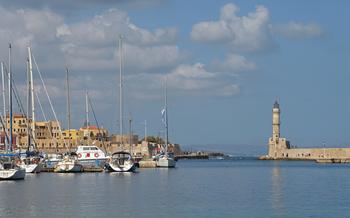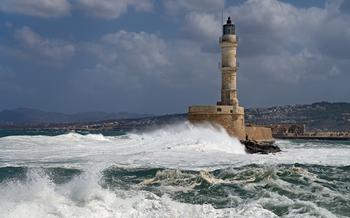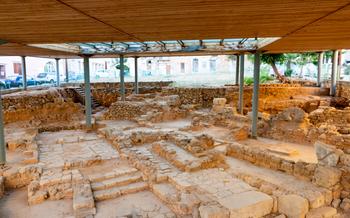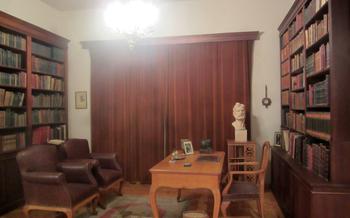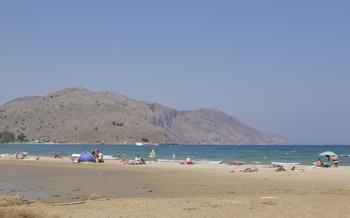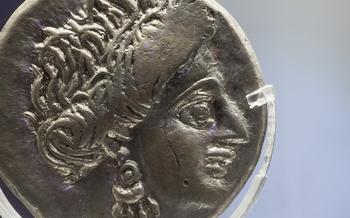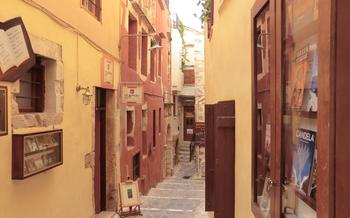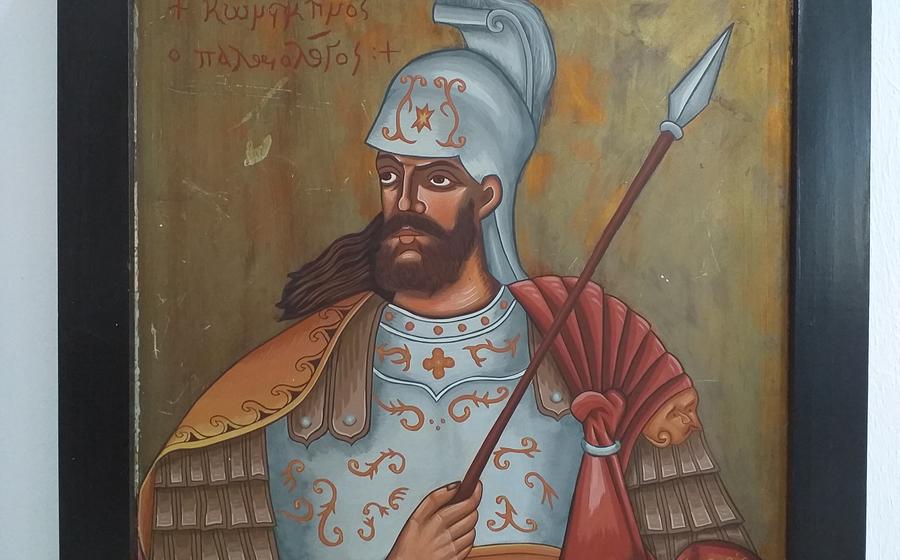
Maritime Museum of Crete
- Historical Background
- Exhibits and Artifacts
- Interactive Displays
- The Shipbuilding Tradition
- Naval Battles and Piracy
- The Venetian and Ottoman Periods:
- The Maritime Museum Building
- Educational Programs and Workshops
- Temporary Exhibitions
- Guided Tours
- Souvenir Shop
- Accessibility
- Location and Transportation
- Insider Tip:
Historical Background
Step into the Maritime Museum of Crete, a treasure trove of maritime history that unveils the rich legacy of Crete's seafaring traditions. From ancient Minoan civilizations to the Venetian and Ottoman empires, Crete's strategic location in the Mediterranean has shaped its maritime destiny. Explore the museum's exhibits and uncover tales of naval battles, shipbuilding expertise, and the pivotal role of Chania's harbor in trade and warfare. Discover the unique stories and contributions of Cretan seafarers, who braved the open seas, connecting cultures and shaping the course of history.
Exhibits and Artifacts
The Maritime Museum of Crete boasts a treasure trove of maritime artifacts that transport visitors back in time. Immerse yourself in a world of model ships, meticulously crafted to replicate the vessels that once sailed the seas. These models showcase the ingenuity and artistry of shipbuilders from different eras, from ancient galleys to modern warships.
Discover a fascinating collection of navigational instruments, the tools that guided sailors across vast oceans. Marvel at the intricate astrolabes, compasses, and sextants, which allowed seafarers to determine their position and course. Touchscreens and interactive displays provide in-depth information about these instruments, shedding light on the challenges and triumphs of navigation in the pre-GPS era.
Admire the impressive array of maritime art and sculptures that adorn the museum's galleries. Local and international artists have captured the essence of the sea and its connection to Crete in a variety of mediums. From breathtaking paintings of crashing waves to sculptures that evoke the power and grace of sailing ships, these works of art add a layer of beauty and emotion to the museum experience.
Interactive Displays
Step into a world of immersive learning as you engage with interactive exhibits that bring history to life. Take the helm of a virtual ship simulator, navigating treacherous seas and facing the challenges of ancient mariners. Explore touchscreens with in-depth information on maritime history, providing insights into the lives of seafarers and their remarkable journeys. Be captivated by audio-visual presentations and multimedia displays, recounting tales of bravery, adventure, and the indomitable spirit of those who sailed the seas. And for a truly thrilling experience, don your virtual reality headset and embark on a breathtaking journey through the eyes of a seasoned sailor, feeling the exhilaration of riding the waves and conquering the vast ocean.
The Shipbuilding Tradition
Crete has a rich shipbuilding tradition that dates back centuries. The island's strategic location and abundance of natural resources made it an ideal place for shipbuilding, and Cretan shipbuilders were renowned for their skill and craftsmanship. The Maritime Museum of Crete showcases this rich tradition through a variety of exhibits and displays.
Visitors can see full-scale replicas of ancient and medieval ships, including a Minoan trading vessel, a Byzantine warship, and a Venetian galley. These replicas provide a glimpse into the different types of ships that were built in Crete and the techniques used to construct them. The museum also displays a collection of shipbuilding tools and equipment, as well as models of ships that were built in Crete over the centuries.
One of the highlights of the museum's shipbuilding exhibit is a replica of the "Minoan Prince," a Minoan ship that was discovered in a shipwreck off the coast of Crete in the 1970s. The ship is believed to have been built around 1700 BC and is one of the oldest known ships in the world. The replica of the "Minoan Prince" was built using traditional shipbuilding techniques and materials, and it provides visitors with a unique opportunity to see what a Minoan ship would have looked like in real life.
The Maritime Museum of Crete's shipbuilding exhibit is a fascinating look at one of Crete's most important industries. Visitors can learn about the history of shipbuilding in Crete, see examples of traditional shipbuilding techniques, and admire the work of skilled Cretan shipbuilders.
Naval Battles and Piracy
Crete's strategic location and its long maritime history have made it a witness to numerous naval battles that shaped the course of history. In the 16th century, the island was a battleground between the Holy League, led by the Venetians, and the Ottoman Empire in the Battle of Lepanto, one of the largest naval battles in history.
The outcome of this epic clash significantly influenced the balance of power in the Mediterranean. Piracy was another prevalent aspect of maritime life in the region. Pirates and privateers, often operating out of hidden coves and islands around Crete, preyed on merchant ships and coastal settlements, creating a climate of fear and uncertainty.
The museum's exhibits provide insights into the tactics, strategies, and challenges faced by navies and pirates during this turbulent period. Visitors can learn about the weapons, ships, and fortifications used in naval warfare, as well as the daring exploits and infamous figures associated with piracy in the Mediterranean Sea.
The Venetian and Ottoman Periods:
The Maritime Museum of Crete is a treasure trove of artifacts and documents that shed light on the influence of Venetian and Ottoman rule on Crete's maritime history and culture. Visitors can explore exhibits that showcase the administrative, military, and cultural aspects of these periods.
During the Venetian period (1204-1669), Crete was a strategic naval base for the Republic of Venice, and the island's shipyards played a vital role in the construction and maintenance of the Venetian fleet. The museum displays model ships, navigational instruments, and other artifacts that provide insights into Venetian shipbuilding techniques and maritime prowess.
The Ottoman period (1669-1898) marked a significant shift in Crete's maritime history. The Ottomans introduced new shipbuilding methods and technologies, and the island's ports became important centers for trade and commerce. The museum exhibits documents and artifacts that illustrate the Ottoman administration of the island, including tax records, legal documents, and maps.
The Maritime Museum Building
The Maritime Museum of Crete is housed in a magnificent building that has witnessed centuries of history. Originally constructed as a Venetian shipyard in the 14th century, the building served as a vital hub for shipbuilding and naval activities during the Venetian era. Its strategic location on the waterfront made it an essential part of Chania's maritime infrastructure.
After the Ottoman conquest of Crete in the 17th century, the building underwent a transformation, becoming a mosque known as the Giali Tzami. The Ottomans retained the building's original structure but added distinctive Islamic architectural elements, such as a minaret and a mihrab. These features blended harmoniously with the existing Venetian architecture, creating a unique architectural fusion that reflects Crete's rich cultural heritage.
In the 20th century, the building was repurposed as the Maritime Museum of Crete, showcasing the island's rich maritime history and traditions. The museum's exhibits and displays are thoughtfully arranged within the building's historic spaces, allowing visitors to immerse themselves in the maritime heritage of Crete while appreciating the architectural beauty of the building itself.
Educational Programs and Workshops
The Maritime Museum of Crete offers a variety of educational programs and workshops for visitors of all ages, providing a deeper immersion into the world of maritime history and culture. These programs are designed to engage learners through hands-on activities, interactive demonstrations, and expert-led discussions.
Families with children can participate in workshops that introduce the basics of shipbuilding, navigation, and seafaring in a fun and interactive way. Children can build their own model ships, learn how to use a compass, and explore the museum's collection through interactive games and activities.
For adults and enthusiasts, the museum offers specialized workshops and lectures on specific maritime topics, such as traditional shipbuilding techniques, naval history, and the role of maritime trade in the development of Crete. These workshops provide an opportunity to engage with experts in the field and gain insights into their research and work.
By participating in these educational programs and workshops, visitors can gain a deeper understanding of maritime history and culture, while also fostering their creativity, curiosity, and problem-solving skills.
Temporary Exhibitions
The Maritime Museum of Crete not only houses a permanent collection but also organizes captivating temporary exhibitions that delve into specific aspects of maritime history and culture. These exhibitions showcase special collections, themed displays, and the work of contemporary artists and researchers.
Temporary exhibitions at the museum provide a fresh perspective on maritime history and allow visitors to explore new and emerging themes. They often feature rare artifacts, immersive multimedia presentations, and interactive installations that engage visitors of all ages.
To stay updated on upcoming temporary exhibitions, check the museum's website or follow its social media channels. These exhibitions offer a chance to learn about the latest research in maritime studies, discover new artistic expressions, and gain a deeper understanding of the diverse facets of maritime culture.
Guided Tours
To truly delve into the depths of maritime history, embark on a guided tour led by knowledgeable experts. These experienced guides will provide insights and anecdotes that bring the exhibits to life, revealing the hidden stories behind the artifacts and showcasing the significance of Crete's maritime legacy. Customize your tour to focus on specific themes or areas of interest, such as ancient shipbuilding techniques, naval battles, or the influence of Venetian and Ottoman rule. Engage in thought-provoking discussions and gain a deeper understanding of the rich maritime heritage of Crete. Booking a guided tour is highly recommended to make the most of your visit and leave with a lasting impression of the museum's treasures.
Souvenir Shop
After exploring the captivating exhibits of the Maritime Museum of Crete, make sure to visit the museum's gift shop to take home a unique souvenir of your visit. The shop offers a wide range of items to suit every taste and budget, from books and postcards to replicas of maritime artifacts and handmade crafts inspired by the museum's collection.
Whether you're looking for a special gift for a loved one or a memento to remind you of your time in Chania, the Maritime Museum gift shop has something for everyone. Support the museum's educational and research initiatives by purchasing souvenirs, and take a piece of maritime history home with you.
Accessibility
The Maritime Museum of Crete is committed to providing an accessible and inclusive environment for all visitors, regardless of their abilities. The museum features wheelchair ramps and elevators to ensure that all levels of the museum are accessible to visitors with mobility impairments. Assisted listening devices and sign language interpreters are available upon request, allowing visitors with hearing or speech impairments to fully participate in guided tours and educational programs. The museum's website provides detailed information on accessibility features and services, ensuring that visitors with disabilities can plan their visit accordingly.
Location and Transportation
The Maritime Museum of Crete is conveniently located in the heart of Chania's Old Town, making it easily accessible on foot from many other attractions. The museum is situated on the waterfront, along the picturesque Venetian harbor, offering stunning views of the sea and the surrounding area. Visitors can easily spend an entire day exploring the museum and the charming streets of the Old Town, with its narrow alleys, colorful buildings, and lively atmosphere.
To reach the museum, public transportation options are readily available. Several bus lines stop within a short walking distance, and taxis are also easily accessible. For those driving, there are several parking options nearby, including both public parking lots and street parking. The museum's central location and convenient transportation options make it an ideal destination for visitors exploring Chania and its rich maritime history.
Insider Tip:
To fully immerse yourself in Chania's maritime heritage, plan your visit to the Maritime Museum of Crete during the off-season, from November to March. The cooler weather and fewer crowds will allow you to explore the exhibits at your own pace and engage with the museum staff more personally. Take advantage of this quieter time to delve deeper into the stories behind the artifacts and learn more about Crete's rich maritime past.
After your visit, enhance your experience with a leisurely stroll along the picturesque Venetian harbor, where you can admire the charming architecture, colorful fishing boats, and stunning sea views. Conclude your maritime journey with a delicious seafood meal at one of the many excellent restaurants lining the harbor. Savor the freshest catches of the day while enjoying the vibrant atmosphere and the panoramic views of the Mediterranean Sea.
